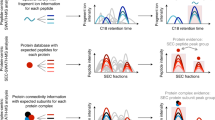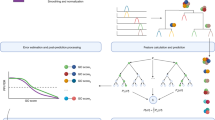Abstract
Protein complexes exhibit great diversity in protein membership, post-translational modifications and noncovalent cofactors, enabling them to function as the actuators of many important biological processes. The exposition of these molecular features using current methods lacks either throughput or molecular specificity, ultimately limiting the use of protein complexes as direct analytical targets in a wide range of applications. Here, we apply native proteomics, enabled by a multistage tandem MS approach, to characterize 125 intact endogenous complexes and 217 distinct proteoforms derived from mouse heart and human cancer cell lines in discovery mode. The native conditions preserved soluble protein–protein interactions, high-stoichiometry noncovalent cofactors, covalent modifications to cysteines, and, remarkably, superoxide ligands bound to the metal cofactor of superoxide dismutase 2. These data enable precise compositional analysis of protein complexes as they exist in the cell and demonstrate a new approach that uses MS as a bridge to structural biology.
This is a preview of subscription content, access via your institution
Access options
Access Nature and 54 other Nature Portfolio journals
Get Nature+, our best-value online-access subscription
$29.99 / 30 days
cancel any time
Subscribe to this journal
Receive 12 print issues and online access
$259.00 per year
only $21.58 per issue
Buy this article
- Purchase on Springer Link
- Instant access to full article PDF
Prices may be subject to local taxes which are calculated during checkout




Similar content being viewed by others
Accession codes
References
Varambally, S. et al. The polycomb group protein EZH2 is involved in progression of prostate cancer. Nature 419, 624–629 (2002).
Alcorta, D.A. et al. Involvement of the cyclin-dependent kinase inhibitor p16 (INK4a) in replicative senescence of normal human fibroblasts. Proc. Natl. Acad. Sci. USA 93, 13742–13747 (1996).
Dunaief, J.L. et al. The retinoblastoma protein and BRG1 form a complex and cooperate to induce cell cycle arrest. Cell 79, 119–130 (1994).
Hummon, A.B. et al. From the genome to the proteome: uncovering peptides in the Apis brain. Science 314, 647–649 (2006).
Choudhary, C. et al. Lysine acetylation targets protein complexes and co-regulates major cellular functions. Science 325, 834–840 (2009).
Tran, J.C. et al. Mapping intact protein isoforms in discovery mode using top-down proteomics. Nature 480, 254–258 (2011).
Catherman, A.D. et al. Large-scale top-down proteomics of the human proteome: membrane proteins, mitochondria, and senescence. Mol. Cell. Proteomics 12, 3465–3473 (2013).
Wu, S. et al. Top-down characterization of the post-translationally modified intact periplasmic proteome from the bacterium Novosphingobium aromaticivorans. Int. J. Proteomics 2013, 279590 (2013).
Zhou, M. et al. Mass spectrometry of intact V-type ATPases reveals bound lipids and the effects of nucleotide binding. Science 334, 380–385 (2011).
Li, H., Wongkongkathep, P., Van Orden, S.L., Ogorzalek Loo, R.R. & Loo, J.A. Revealing ligand binding sites and quantifying subunit variants of noncovalent protein complexes in a single native top-down FTICR MS experiment. J. Am. Soc. Mass Spectrom. 25, 2060–2068 (2014).
Fenn, J.B., Mann, M., Meng, C.K., Wong, S.F. & Whitehouse, C.M. Electrospray ionization for mass spectrometry of large biomolecules. Science 246, 64–71 (1989).
Palczewski, K. et al. Crystal structure of rhodopsin: A G protein-coupled receptor. Science 289, 739–745 (2000).
Baradaran, R., Berrisford, J.M., Minhas, G.S. & Sazanov, L.A. Crystal structure of the entire respiratory complex I. Nature 494, 443–448 (2013).
Bachir, A.I. et al. Integrin-associated complexes form hierarchically with variable stoichiometry in nascent adhesions. Curr. Biol. 24, 1845–1853 (2014).
Du, J., Lü, W., Wu, S., Cheng, Y. & Gouaux, E. Glycine receptor mechanism elucidated by electron cryo-microscopy. Nature 526, 224–229 (2015).
Kühlbrandt, W. Biochemistry. The resolution revolution. Science 343, 1443–1444 (2014).
Sheng, M., Cummings, J., Roldan, L.A., Jan, Y.N. & Jan, L.Y. Changing subunit composition of heteromeric NMDA receptors during development of rat cortex. Nature 368, 144–147 (1994).
Link, A.J. et al. Direct analysis of protein complexes using mass spectrometry. Nat. Biotechnol. 17, 676–682 (1999).
Havugimana, P.C. et al. A census of human soluble protein complexes. Cell 150, 1068–1081 (2012).
Huttlin, E.L. et al. The BioPlex Network: A Systematic Exploration of the Human Interactome. Cell 162, 425–440 (2015).
Rees, J.S. et al. In vivo analysis of proteomes and interactomes using Parallel Affinity Capture (iPAC) coupled to mass spectrometry. Mol. Cell Proteomics 10, M110.2386 (2011).
Belov, M.E. et al. From protein complexes to subunit backbone fragments: a multi-stage approach to native mass spectrometry. Anal. Chem. 85, 11163–11173 (2013).
Skinner, O.S. et al. Native GELFrEE: a new separation technique for biomolecular assemblies. Anal. Chem. 87, 3032–3038 (2015).
Melani, R.D. et al. CN-GELFrEE - Clear Native Gel-eluted Liquid Fraction Entrapment Electrophoresis. J. Vis. Exp. 2016, 53597 (2016).
Skinner, O.S. et al. An informatic framework for decoding protein complexes by top-down mass spectrometry. Nat. Methods 13, 237–240 (2016).
Smith, L.M., Kelleher, N.L. & The Consortium for Top Down Proteomics Proteoform: a single term describing protein complexity. Nat. Methods 10, 186–187 (2013).
Havugimana, P.C., Wong, P. & Emili, A. Improved proteomic discovery by sample pre-fractionation using dual-column ion-exchange high performance liquid chromatography. J. Chromatogr. B Analyt. Technol. Biomed. Life Sci. 847, 54–61 (2007).
Skinner, O.S., Schachner, L.F. & Kelleher, N.L. The search engine for multi-proteoform complexes: an online tool for the identification and stoichiometry determination of protein complexes. Curr. Protoc. Bioinformatics 56, 13.30.1–13.30.11 (2016).
van de Waterbeemd, M. et al. High-fidelity mass analysis unveils heterogeneity in intact ribosomal particles. Nat. Methods 14, 283–286 (2017).
Bakkenist, C.J. & Kastan, M.B. DNA damage activates ATM through intermolecular autophosphorylation and dimer dissociation. Nature 421, 499–506 (2003).
McMahon, C.G. et al. Diagnostic accuracy of heart-type fatty acid-binding protein for the early diagnosis of acute myocardial infarction. Am. J. Emerg. Med. 30, 267–274 (2012).
Liu, F., Rijkers, D.T., Post, H. & Heck, A.J. Proteome-wide profiling of protein assemblies by cross-linking mass spectrometry. Nat. Methods 12, 1179–1184 (2015).
Foster, A.W., Osman, D. & Robinson, N.J. Metal preferences and metallation. J. Biol. Chem. 289, 28095–28103 (2014).
Zheng, W. et al. The crystal structure of human isopentenyl diphosphate isomerase at 1.7 A resolution reveals its catalytic mechanism in isoprenoid biosynthesis. J. Mol. Biol. 366, 1447–1458 (2007).
Costello, L.C., Liu, Y., Franklin, R.B. & Kennedy, M.C. Zinc inhibition of mitochondrial aconitase and its importance in citrate metabolism of prostate epithelial cells. J. Biol. Chem. 272, 28875–28881 (1997).
Robbins, A.H. & Stout, C.D. Structure of activated aconitase: formation of the [4Fe-4S] cluster in the crystal. Proc. Natl. Acad. Sci. USA 86, 3639–3643 (1989).
Kang, H.J., Jung, S.K., Kim, S.J. & Chung, S.J. Structure of human alpha-enolase (hENO1), a multifunctional glycolytic enzyme. Acta Crystallogr. D Biol. Crystallogr. 64, 651–657 (2008).
Emanuelsson, O., Nielsen, H., Brunak, S. & von Heijne, G. Predicting subcellular localization of proteins based on their N-terminal amino acid sequence. J. Mol. Biol. 300, 1005–1016 (2000).
Oyer, J.A. et al. Point mutation E1099K in MMSET/NSD2 enhances its methyltranferase activity and leads to altered global chromatin methylation in lymphoid malignancies. Leukemia 28, 198–201 (2014).
Durbin, K.R. et al. Quantitation and identification of thousands of human proteoforms below 30 kDa. J. Proteome Res. 15, 976–982 (2016).
Yang, Y., Barendregt, A., Kamerling, J.P. & Heck, A.J. Analyzing protein micro-heterogeneity in chicken ovalbumin by high-resolution native mass spectrometry exposes qualitatively and semi-quantitatively 59 proteoforms. Anal. Chem. 85, 12037–12045 (2013).
Sasaki, T. & Takai, Y. The Rho small G protein family-Rho GDI system as a temporal and spatial determinant for cytoskeletal control. Biochem. Biophys. Res. Commun. 245, 641–645 (1998).
Eliot, A.C. & Kirsch, J.F. Pyridoxal phosphate enzymes: mechanistic, structural, and evolutionary considerations. Annu. Rev. Biochem. 73, 383–415 (2004).
Reddy, S., Jones, A.D., Cross, C.E., Wong, P.S. & Van Der Vliet, A. Inactivation of creatine kinase by S-glutathionylation of the active-site cysteine residue. Biochem. J. 347, 821–827 (2000).
Wilson, M.A. The role of cysteine oxidation in DJ-1 function and dysfunction. Antioxid. Redox Signal. 15, 111–122 (2011).
Vigushin, D.M. et al. Trichostatin A is a histone deacetylase inhibitor with potent antitumor activity against breast cancer in vivo. Clin. Cancer Res. 7, 971–976 (2001).
Zhao, S. et al. Regulation of cellular metabolism by protein lysine acetylation. Science 327, 1000–1004 (2010).
Weinert, B.T. et al. Acetylation dynamics and stoichiometry in Saccharomyces cerevisiae. Mol. Syst. Biol. 10, 716 (2014).
Skinner, O.S. & Kelleher, N.L. Illuminating the dark matter of shotgun proteomics. Nat. Biotechnol. 33, 717–718 (2015).
Takai, Y., Sasaki, T. & Matozaki, T. Small GTP-binding proteins. Physiol. Rev. 81, 153–208 (2001).
Zhang, Z. & Marshall, A.G. A universal algorithm for fast and automated charge state deconvolution of electrospray mass-to-charge ratio spectra. J. Am. Soc. Mass Spectrom. 9, 225–233 (1998).
Strohalm, M., Kavan, D., Novák, P., Volný, M. & Havlícek, V. mMass 3: a cross-platform software environment for precise analysis of mass spectrometric data. Anal. Chem. 82, 4648–4651 (2010).
Ruepp, A. et al. CORUM: the comprehensive resource of mammalian protein complexes--2009. Nucleic Acids Res. 38, D497–D501 (2010).
Acknowledgements
Funding for this project was provided by the W.M. Keck foundation (DT061512) and Northwestern University. This research was also supported by the Paul G. Allen Family Foundation (Grant Award 11715). The authors would also like to acknowledge helpful discussion with A. Catherman, R. Fellers, J. Greer, and B. Early. Helpful assistance from Thermo Fisher Scientific was provided by M. Belov, S. Horning, and A. Makarov. OSS and PFD are supported by US National Science Foundation graduate research fellowships (2014171659 and 2015210477, respectively). LHFDV is supported under CNPq research grant 400301/2014-8 from the Brazilian government. LFS was supported by the Chemistry of Life Processes Predoctoral training program at Northwestern University. Additional support for the maintenance of the SEMPC from the National Resource for Translational and Developmental Proteomics (GM108569) is acknowledged.
Author information
Authors and Affiliations
Contributions
Data acquisition and analysis was performed by O.S.S. with assistance from N.A.H., L.F., R.D.M., and from all authors. N.A.H., R.D.M., L.F., L.H.F.D.V., H.S.S., and P.F.D. prepared samples with help from O.S.S. and L.F.S. O.S.S. wrote the manuscript with critical insights from P.D.C. and additional assistance from K.S. and all co-authors. N.L.K. and P.D.C. conceived of and oversaw the project.
Corresponding authors
Ethics declarations
Competing interests
N.L.K. serves as a paid consultant to Thermo Fisher Scientific, whose instruments were used in this work.
Supplementary information
Supplementary Text and Figures
Supplementary Results, Supplementary Tables 1–2 and Supplementary Figures 1–18 (PDF 25511 kb)
Supplementary Dataset 1
Supplementary Data Set 1 (XLSX 26 kb)
Supplementary Dataset 2
Supplementary Data Set 2 (XLSX 36 kb)
Rights and permissions
About this article
Cite this article
Skinner, O., Haverland, N., Fornelli, L. et al. Top-down characterization of endogenous protein complexes with native proteomics. Nat Chem Biol 14, 36–41 (2018). https://doi.org/10.1038/nchembio.2515
Received:
Accepted:
Published:
Issue Date:
DOI: https://doi.org/10.1038/nchembio.2515
This article is cited by
-
Structure and dynamics of endogenous cardiac troponin complex in human heart tissue captured by native nanoproteomics
Nature Communications (2023)
-
Direct determination of oligomeric organization of integral membrane proteins and lipids from intact customizable bilayer
Nature Methods (2023)
-
Studying protein structure and function by native separation–mass spectrometry
Nature Reviews Chemistry (2022)
-
Native mass spectrometry analyses of chaperonin complex TRiC/CCT reveal subunit N-terminal processing and re-association patterns
Scientific Reports (2021)
-
Native mass spectrometry reveals the initial binding events of HIV-1 rev to RRE stem II RNA
Nature Communications (2020)



